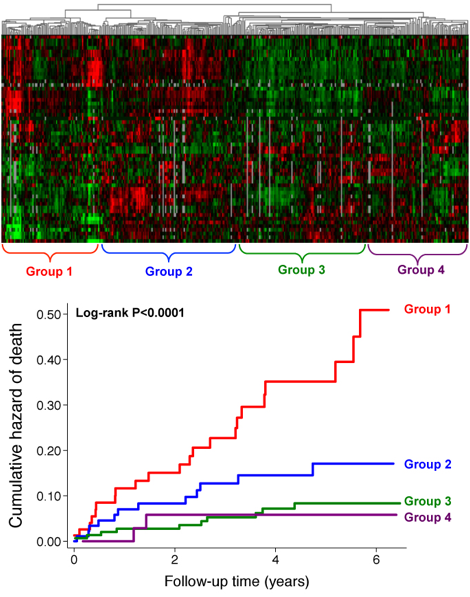Session Information
Session Type: Abstract Submissions (ACR)
Background/Purpose: Traditional studies of systemic sclerosis (SSc) cardiac involvement have examined one or a few echocardiographic (echo) variables; however, cardiac involvement in SSc can be multi-faceted and heterogeneous. We hypothesized that evaluation of dense quantitative echo phenotypic data using repurposed genetic analytic software would allow for novel classification of SSc cardiac involvement.
Methods: We studied 377 patients with SSc enrolled in the Northwestern Scleroderma Program. All patients underwent comprehensive echo with Doppler and tissue Doppler imaging using a standardized protocol for image acquisition and interpretation. A total of 57 unique, quantitative echo phenotypes were standardized to mean=0 and SD=±1. The quantitative phenotypic data was entered into gene expression analysis software (Cluster), and a phenotype heatmap (“pheno-map”) was generated (TreeView). Cluster groups (“pheno-groups”) were defined based on the resultant heriarchical dendogram. We used linear, logistic, and Cox regression analyses to determine differences in clinical, laboratory, pulmonary function testing, and survival characteristics among pheno-groups.
Results: The mean±SD age was 51±13 years, 82% were female, 51% had limited cutaneous SSc, 32% had diffuse cutaneous SSc, and 17% had other forms of SSc (e.g., overlap syndromes). Prevalence of SSc complications were as follows: PAH in 9%, ILD in 17.5%, and LV systolic dysfunction (EF<50%) in 4%. After the phenomapping analysis, 4 distinct, mutually exclusive pheno-groups were identified. The 4 groups differed significantly on clinical characteristics and outcomes. The pheno-groups did not differ by SSc subtype (limited vs. diffuse cutaneous SSc), but autoantibodies did differ by pheno-group (e.g., anti-centromere antibody was most prevalent in pheno-group #4 [38%]). PAH prevalence differed across groups (highest [18.5%] in pheno-group #1, P=0.002). Clinical ILD did not differ among groups (P=0.24), but FVC and DLCO were lowest in pheno-group #1 (P<0.001). LV, RV, and left atrial mechanics were also worse in pheno-group #1 (P<0.02 for all comparisons). Pheno-group #1 had the highest risk for death (HR 6.0, 95% CI 1.3-28.5; P=0.024 after adjustment for age, sex, SSc subtype, disease duration, ILD, and PAH).
Conclusion: Heirarchical cluster analysis of high-density, quantitative echo phenotypes results in novel, clinically relevant classification of cardiac structure/function in SSc. Further research into the identified echo pheno-groups of SSc may enhance pathophysiologic insight into SSc cardiac involvement.
Figure. Echocardiographic Phenotype Heatmap “Pheno-Map” (top panel) and Cumulative Hazard for Death by Pheno-Group (bottom panel)
Disclosure:
M. Hinchcliff,
Gilead Science,
9;
V. Daruwalla,
None;
L. Beussink-Nelson,
None;
S. Podlusky,
None;
M. A. Carns,
None;
J. Varga,
None;
S. J. Shah,
None.
« Back to 2014 ACR/ARHP Annual Meeting
ACR Meeting Abstracts - https://acrabstracts.org/abstract/echocardiographic-phenomics-for-novel-classification-of-cardiac-involvement-in-systemic-sclerosis/

